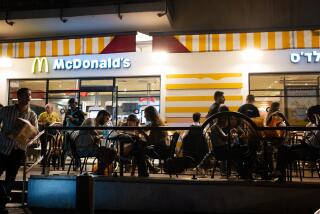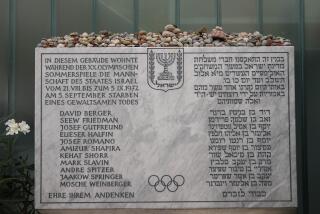Nazi Factory Conscripts Are Rebuffed : Claims: German chemical firm refuses to compensate 8,000 survivors, saying it’s a national problem.
- Share via
FRANKFURT, Germany — I. G. Farben, the chemical company that enslaved prisoners of Nazi concentration camps in its factories during World War II, Wednesday refused to compensate 8,000 East European survivors.
At a raucous meeting of shareholders, the board decided instead to ask the German government to compensate the survivors and count the payments against government-held property the company claims in eastern Germany.
“The Holocaust isn’t our problem, it’s all of Germany’s problem,” said Ernst C. Krienke, head of the board. “We’re just the company that everyone hangs it on.”
Some shareholders have been trying to force I. G. Farben and three chemical giants created from its breakup--BASF, Hoechst and Bayer--to do more to compensate victims of the Holocaust. The latter three companies argue that they were founded as new independent enterprises.
Survivor groups see the very existence of I. G. Farben as an insult and called Wednesday’s decision a stall tactic. One shareholder, Eduard Bernhard, stood up to demand the immediate dissolution of the company before the start of the meeting.
“I won’t allow it, you blockhead!” Krienke shouted.
Krienke said the company’s first duties were to its shareholders and creditors. In 1957 the company paid $8 million to the U.S.-based Jewish Claims Conference, which compensated an estimated 10,000 Western European, Israeli and U.S. Jews.
It did not pay Eastern European Jews and non-Jewish victims, including thousands of Poles. Krienke said that was because there was no bilateral German treaty with the eastern states that authorized such payments.
I. G. Farben employed an estimated 350,000 prisoners at its chemical factories during the war. About 30,000 people died working its factory at the Auschwitz concentration camp alone.
Among other things, I. G. Farben made the Zyklon-B tablets the Nazis used in gassing camp inmates.
The conglomerate was dismantled after the war but re-created in the 1950s as a shell company to deal with lawsuits, reparations and property claims.
It was given new life by German unification, when it laid claim to 58 square miles of property in the former East Germany--where it was the largest single property owner in 1945.
I. G. Farben’s estimated 8,000 shareholders are hoping to cash in on a settlement of the property claims, which are expected to be tied up in legal battles for years.
About a dozen people holding signs denouncing the company stood outside the Frankfurt hotel where the shareholders meeting was held.
Among them was Peter Gingold, a 79-year-old Jew whose family died at Auschwitz. Gingold’s sign read, “My Brother and Sister Were Murdered With Poison Gas From I. G. Farben.”
“The existence of this company makes a mockery of its victims,” Gingold said. “Their shares are stained with blood.”
The newly approved restitution plan is vague, puts the burden of responsibility on German taxpayers and could take years to resolve, Gingold said.
More to Read
Sign up for Essential California
The most important California stories and recommendations in your inbox every morning.
You may occasionally receive promotional content from the Los Angeles Times.










